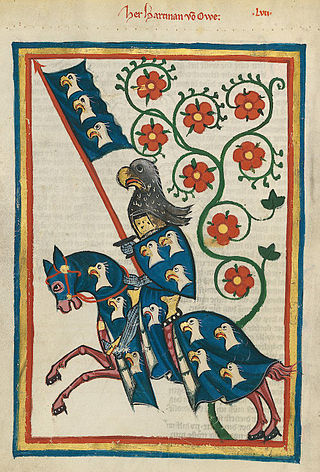
A knight is a person granted an honorary title of knighthood by a head of state or representative for service to the monarch, the church or the country, especially in a military capacity. Knighthood finds origins in the ancient Greek hippeis (ἱππεῖς) and Roman equites.

Jousting is a medieval and renaissance martial game or hastilude between two combatants either on horse or on foot. The joust became an iconic characteristic of the knight in Romantic medievalism.

Stage combat, fight craft or fight choreography is a specialised technique in theatre designed to create the illusion of physical combat without causing harm to the performers. It is employed in live stage plays as well as operatic and ballet productions. With the advent of cinema and television the term has widened to also include the choreography of filmed fighting sequences, as opposed to the earlier live performances on stage. It is closely related to the practice of stunts and is a common field of study for actors. Actors famous for their stage fighting skills frequently have backgrounds in dance, gymnastics or martial arts training.
Maestro Ramón Martínez is an American master of classical and historical fencing. He studied classical fencing with the late Maître d'Armes Frederick Rohdes in New York City for ten years. Maître Rohdes was one of the last fencing masters to teach fencing as a martial art, himself having learned a variety of historical fencing systems from his own master, Maître d'Armes Marcel Cabijos. During that time Mr. Martínez became assistant and protégé of Maître Rohdes and was the only one of his pupils permitted to teach with full authorization at the Rohdes Academy.

A tournament, or tourney, was a chivalrous competition or mock fight in the Middle Ages and Renaissance, and is a type of hastilude. Tournaments included mêlée, hand-to-hand combat, contests of strength, accuracy, and sometimes jousts. Although some thought that the tournaments were a threat to public order, the shows were still often held to celebrate coronations, marriages of notable figures, births, recent conquests, peace treatises; to welcome those considered of great importance, such as ambassadors and lords; or for no particular reason at all, and simply for entertainment. Certain tournaments are depicted throughout the Codex Manesse.
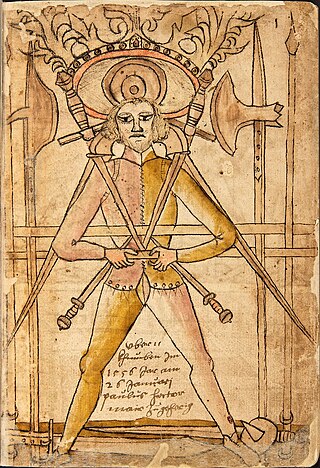
Historical European martial arts (HEMA) are martial arts of European origin, particularly using arts formerly practised, but having since died out or evolved into very different forms.
Martial arts manuals are instructions, with or without illustrations, specifically designed to be learnt from a book. Many books detailing specific techniques of martial arts are often erroneously called manuals but were written as treatises.

Medieval reenactment is a form of historical reenactment that focuses on re-enacting European history in the period from the fall of Rome to about the end of the 15th century. The second half of this period is often called the Middle Ages. This multiplicity of terms is compounded by the variety of other terms used for the period.

Jacques de Lalaing (1421–1453), perhaps the most renowned knight of Burgundy in the 15th century, was reportedly one of the best medieval tournament fighters of all time. A Walloon knight, he began his military career in the service of Adolph I, Duke of Cleves, but was quickly noticed by Philip the Good, Duke of Burgundy by whom he was knighted and whom he went on to serve. Jacques, known as the "Bon Chevalier" due to his military prowess in tournaments and battles, became the most famous Burgundian knight of his time, and was well known throughout Europe as one of the best medieval tournament fighters. Jacques was inducted into the prestigious Burgundian chivalric order, the Order of the Golden Fleece, in 1451. Jacques' deeds in tournaments and battles were recorded in the Livre des Faits de Jacques Lalaing attributed mainly to the Burgundian chroniclers Jean Le Fevre de Saint-Remy, Georges Chastellain, and the herald Charolais. Throughout his life, Jacques was entrusted by the Duke of Burgundy to serve in delegations to the King of France and the Pope, as well as with the suppression of the Revolt of Ghent in 1453.
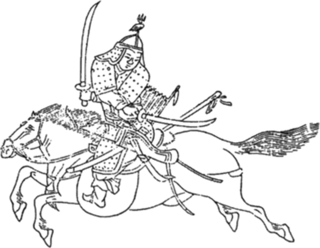
Commissioned in 1790 by King Jeongjo, the Muyedobotongji expanded on the eighteen weapons systems identified in the Muyeshinbo of 1758.
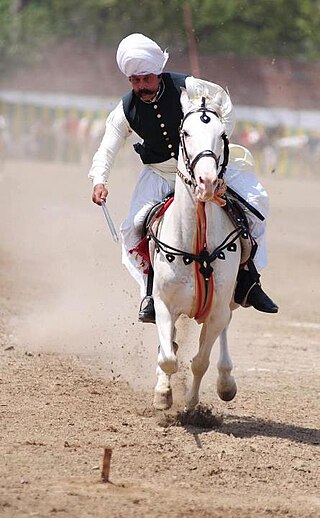
Tent pegging is a cavalry sport of ancient origin, and is one of only ten equestrian disciplines officially recognised by the International Equestrian Federation. Used narrowly, the term refers to a specific mounted game with ground targets. More broadly, it refers to the entire class of mounted cavalry games involving pointed and edged weapons on horseback, for which the term "equestrian skill-at-arms" is also used.
The Society for Creative Anachronism (SCA) is a medieval reenactment group with an international membership, founded in California in 1966. Members of the group participate, to a greater or lesser extent, in a wide variety of activities based on those found in pre-1601 CE cultures. The vast majority of interests in the SCA are either combat-focused, or focused on the day-to-day crafts of the period, known within the Society as A&S. Gatherings of the SCA are events, at which attempts at pre-17th century costume must be worn, and practices or meetings, at which costuming is largely up to each member's discretion—although sufficient safety equipment must always be worn for practicing combat skills.

Although the earliest evidence of martial arts goes back millennia, the true roots are difficult to reconstruct. Inherent patterns of human aggression which inspire practice of mock combat and optimization of serious close combat as cultural universals are doubtlessly inherited from the pre-human stage and were made into an "art" from the earliest emergence of that concept. Indeed, many universals of martial art are fixed by the specifics of human physiology and not dependent on a specific tradition or era.
Chivalry Bookshelf was a small press based in the United States founded by Brian R. Price which published booklets and books from 1992 to 2007. It was most notable for its contributions to the Society of Creative Anachronism and the early historical fencing movement and for a dispute about plagiarism and nonpayment of royalties in 2011-12.
Historical Medieval Battles (HMB) or Buhurt or Armored Combat is a modern full contact fighting sport with steel blunt weapons characteristic for the Middle Ages. Armour and weapons have to follow regulations on historical authenticity and safety published on official Battle of the Nations website.
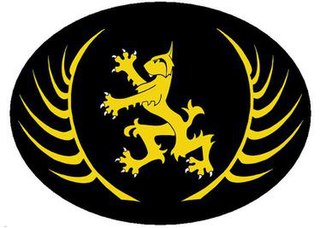
Schola Gladiatoria (SG) is a historical European martial arts (HEMA) group based in Ealing, west London, Great Britain, founded in 2001 and led by Matt Easton. It provides organized instruction in the serious study and practice of historical European swordplay. Schola seeks to be consistent with the methodology of the ancient European fencing schools by combining scholarship and research into the teachings of the historical masters, with the practical knowledge gained through solo and partnered drilling, and free play (sparring).
The practice of Historical European Martial Arts (HEMA) first started in Australia in the late 19th century before largely dying out. There was then a revival of interest in the late 20th century to the current day. The practice of HEMA in Australia has grown to be a popular activity, with clubs all in capital cities, and the larger cities in Australia, Sydney and Melbourne, each have a number of clubs teaching various styles.

Kuk Sool Won means Korean martial arts. It was founded in 1958 by Suh In-Hyuk (서인혁), who also carries the formal titles of Kuk Sa Nim and Grandmaster.
Tobias Emanuel ("Toby") Capwell FSA is an American historian who lives and works in London. His principal interest is in European arms and armour of the medieval and Renaissance periods. He was formerly Curator of Arms and Armour at the Wallace Collection in London. He has written and spoken extensively on both the historical and the practical aspects of his subject. Capwell is also a skilled jouster, and has claimed to be the world's only jousting curator.

John Waller was an English pioneer of the historical European martial arts (HEMA) revival, a fight director for stage, screen and spectacle, and a teacher of martial arts.













